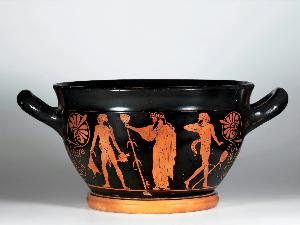Penthesilea Painter
Penthesilea Painter
Biography:
The Penthesilea Painter was a Greek vase painter of the Attic red-figure style, active between 470 and 450 BC at Athens. His true name is unknown, and his conventional name is derived from his name vase, 'bowl 2688' in Munich, the inside of which depicts the slaying of Penthesilea by Achilles. John Beazley attributed 177 known vases to the painter, about 100 of which only survive fragmentarily. His works are characterized by large, space-filling figures, often with bent postures to fit on a vessel. He used a variety of colors, including dark coral red, light red, brown, yellow, yellow-white, and gold. His figures are painted meticulously in every detail, and he appears to have painted the subsidiary or exterior images on his vases himself. His work is dominated by depictions of boys and youths engaged in athletic activity, teaching scenes, weaponry and armour, as well as scenes of people talking to horses. While he painted the occasional mythological motif, they are so rare that they should be considered an exception among his work. Throughout his career, scenes from everyday life gain an increasingly dominant share of his paintings. In his later works, his love of detail is lost and replaced with stencil-like motifs, but his lines remain certain, preserving a distinctive charm. His true mastery is found in the subsidiary images of boys, on which he appears to have concentrated more and more. His major importance for Classical vase painting lies in the fact that he moved away from the usual motifs and replaced them with typical motifs from everyday life, emphasizing human aspects and representing a new departure in the development of vase painting.

